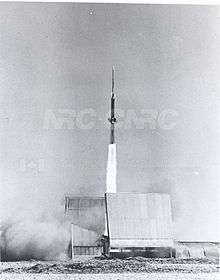Nike-Apache

The Nike Apache was a two-stage sounding rocket used by NASA to loft instruments into the upper atmosphere. The Nike Apache was launched 636 times between 1961 and 1978. It was a popular rocket due to its low cost (US$6000) and ability to be fired from many locales.
The Nike Apache was used to carry a variety of payloads to study a wide range of topics including radio astronomy, meteorology, aeronomy, atmospheric conditions, plasma physics, and solar physics. NASA flew them from Brazil, Canada, India, Norway, Pakistan, Spain, Suriname, Sweden, all across the US, and off the USS Croatan (CVE-25). The maximum payload weight was 80 lb (36 kg) and the maximum altitude about 125 miles (200 km). Nike Apache was the first rocket launched by the India from TERLS (Thumba Equatorial Rocket Launching Station) of Kerala in 1963.
The Nike-Apache configuration was also used by one variation of the MQR-13 BMTS target rocket.[1]
Specifications

General characteristics
- Length: 27.25 ft (8.31 m)
- Diameter: 1 ft 4.5 in (0.42 m)
- Launch mass: 1602.5 lb (728 kg)
Engine
- First stage: 1× solid-propellant rocket
- Thrust: 48,700 lbf (217 kN)
- Second stage: 1× solid-propellant rocket
- Thrust: 4,750 lbf (21,140 N)
References
- ↑ Parsch 2002
- Nike Apache at Encyclopedia Astronautica
- Parsch, Andreas (2002). "USAMICOM MQR-13 BMTS". Directory of U.S. Military Rockets and Missiles. designation-systems.net. Retrieved 2011-01-06.